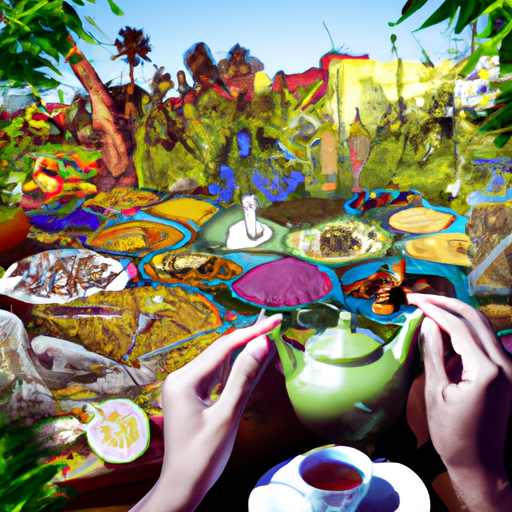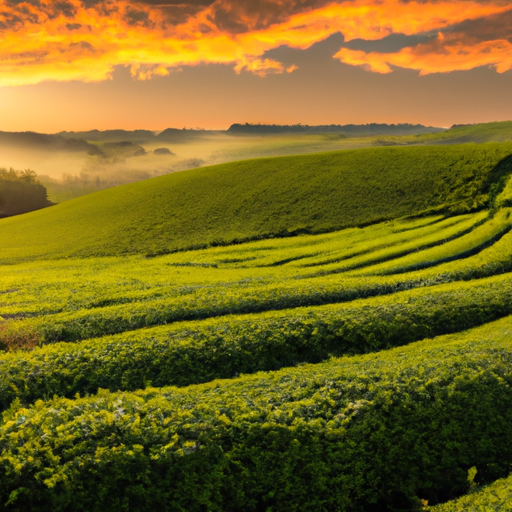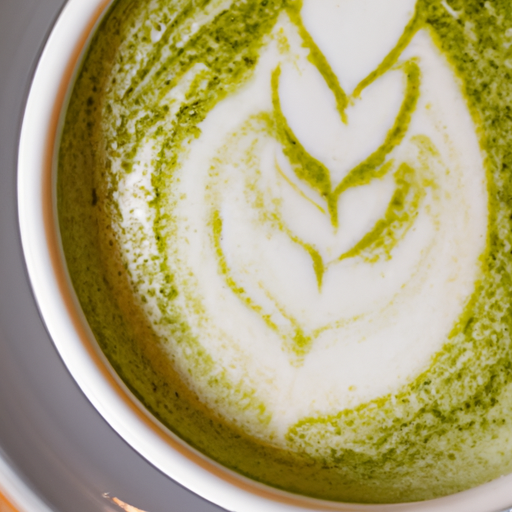As I sit here, sipping my cup of tea, I am reminded of the remarkable journey this humble beverage has taken throughout history. From its ancient origins in China to its expansion into unusual and unexpected places, tea has captivated the hearts and palates of people around the world.
Like a fallen leaf that found its way into Emperor Shen Nong’s cup, tea’s story begins with a stroke of serendipity. This fateful encounter sparked a discovery that would shape the course of human civilization. From that moment, tea production spread like wildfire, crossing borders and transcending cultures.
Today, tea is not confined to its birthplace in China. It has traveled far and wide, establishing its roots in countries across the globe. Japan, Taiwan, India, Sri Lanka, and Africa have all become significant players in the tea industry, each contributing their unique flavors and techniques.
But the journey doesn’t end there. In recent years, tea cultivation has found its way to unexpected corners of the world. Countries like Canada, the Netherlands, Germany, and even Scotland have embraced the art of growing tea, expanding the boundaries of what was once thought possible.
In this article, we will delve into the global journey of tea, exploring its ancient origins, its proliferation in different countries, and the growing popularity that has led to its cultivation in unusual places. So sit back, relax, and join me on this fascinating expedition as we uncover the rich and diverse world of tea.
Key Takeaways
- Tea originated in China and was initially grown only there.
- Tea production has expanded to countries on every continent except Antarctica.
- Different varieties of the tea plant, Camellia sinensis, are used to produce different types of tea.
- Tea production has a long history and has spread to unusual places such as Canada, the Netherlands, Germany, and New Zealand.
The Origin of Tea
I learned that tea originated in China and was initially grown only there, but now it is produced on every continent except Antarctica.
The cultural significance of tea in China is immense, with legends and myths surrounding its discovery by Chinese Emperor Shen Nong. According to one legend, a tea leaf fell into his cup, and he found the taste refreshing and invigorating. This discovery led to the cultivation and widespread consumption of tea in China.
Tea has been deeply integrated into Chinese culture, with tea ceremonies and rituals being an important part of social and cultural gatherings.
As tea production spread to other countries, each region developed its own unique tea traditions and customs.
The global journey of tea has not only expanded its geographical reach but also enriched the cultural diversity and appreciation of this beloved beverage.
Tea Production in Different Countries
Tea production is expanding in various countries around the world, including Canada, the Netherlands, Germany, New Zealand, Spain, Madagascar, Scotland, and Réunion. This expansion is driven by several factors, including the impact of climate change on traditional tea-growing regions and the growing cultural significance of tea in different countries.
-
Canada: With its cooler climate, Canada is now experimenting with tea production in regions such as British Columbia and Ontario. The unique terroir and growing conditions contribute to the production of high-quality artisanal teas.
-
The Netherlands: Known for its horticultural expertise, the Netherlands is embracing tea production in greenhouses. This controlled environment allows for consistent tea cultivation and the creation of unique flavors.
-
Germany: German tea production is centered around the picturesque region of East Frisia. This area has a rich tea-drinking culture and has recently started producing its own teas, including blends with local herbs.
-
New Zealand: New Zealand’s temperate climate and fertile soil provide ideal conditions for tea cultivation. The country is known for its premium black teas, which have gained recognition in global tea competitions.
-
Spain: In recent years, Spain has seen a resurgence in tea production, particularly in the Canary Islands. The volcanic soil and subtropical climate create a unique flavor profile in the teas produced there.
Overall, the expansion of tea production in these countries highlights the adaptability of the tea plant to different climates and the growing appreciation for tea worldwide.
Tea’s Growing Popularity
With its expanding presence in countries around the world, tea is becoming increasingly popular among diverse cultures and demographics. This rising popularity can be attributed to the growing awareness of the numerous health benefits associated with tea consumption. From boosting the immune system to promoting heart health, tea has been praised for its medicinal properties for centuries. Moreover, tea culture and traditions vary across different regions, adding a unique and cultural aspect to the beverage. For example, in Japan, the traditional tea ceremony is a highly revered practice that emphasizes mindfulness and tranquility. In India, chai tea is a staple and is often enjoyed with spices such as cardamom and ginger. By embracing these customs and recognizing the health benefits of tea, people from all walks of life are incorporating this ancient beverage into their daily routines.
| Health Benefits of Tea | Tea Culture and Traditions |
|---|---|
| Boosts the immune system | Traditional Japanese tea ceremony |
| Promotes heart health | Indian chai tea with spices |
| Reduces stress and anxiety | British afternoon tea |
| Improves digestion | Moroccan mint tea |
Frequently Asked Questions
How has the globalization of tea production impacted traditional tea-growing regions?
The globalization of tea production has had a significant impact on traditional tea-growing regions. It has brought about changes in traditional farming practices and has had both positive and negative effects on local economies.
What are some lesser-known types of tea that have gained popularity in recent years?
In recent years, new tea trends have seen the rise of unconventional tea blends. One example is the popular matcha latte, which combines traditional Japanese matcha with frothy milk for a unique and delicious beverage.
Are there any cultural or historical rituals associated with tea consumption in different countries?
Japanese tea ceremonies and British afternoon tea are two cultural rituals associated with tea consumption. Japanese tea ceremonies emphasize harmony, respect, and tranquility, while British afternoon tea is a social occasion with tea, sandwiches, and pastries.
How has technology influenced the processing and packaging of tea?
Automation and innovations in tea processing and packaging technologies have had a profound impact. The integration of artificial intelligence has improved efficiency, quality control, and sustainability in tea production, ensuring a consistent and enjoyable tea experience for consumers worldwide.
What are some unique health benefits or medicinal properties associated with specific types of tea?
Unique tea flavors and their associated health benefits are vast. For example, green tea can boost brain function, chamomile tea can improve sleep quality, and matcha tea can enhance concentration and focus. Tea can also have a calming effect on mental health.
Conclusion
In conclusion, the global journey of tea has been a fascinating one, from its ancient origins in China to its spread across different countries. Despite its long history, tea production continues to expand and thrive in unusual places around the world.
While some may argue that tea should only be grown in traditional tea-growing regions, the success of tea cultivation in countries like Canada, the Netherlands, and New Zealand proves that tea can adapt to different climates and still maintain its unique flavors and qualities. This showcases the versatility and resilience of tea as a globally beloved beverage.










